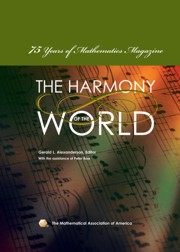Book contents
- Frontmatter
- Introduction
- Contents
- A Brief History of Mathematics Magazine
- Part I The First Fifteen Years
- Perfect Numbers
- Rejected Papers of Three Famous Mathematicians
- Review of Men of Mathematics
- Oslo under the Integral Sign
- Vigeland's Monument to Abel in Oslo
- The History of Mathematics
- Numerical Notations and Their Influence on Mathematics
- Part II The 1940s
- Part III The 1950s
- Part IV The 1960s
- Part V The 1970s
- Part VI The 1980s
- Briefly Noted
- The Problem Section
- Index
- About the Editors
Perfect Numbers
from Part I - The First Fifteen Years
- Frontmatter
- Introduction
- Contents
- A Brief History of Mathematics Magazine
- Part I The First Fifteen Years
- Perfect Numbers
- Rejected Papers of Three Famous Mathematicians
- Review of Men of Mathematics
- Oslo under the Integral Sign
- Vigeland's Monument to Abel in Oslo
- The History of Mathematics
- Numerical Notations and Their Influence on Mathematics
- Part II The 1940s
- Part III The 1950s
- Part IV The 1960s
- Part V The 1970s
- Part VI The 1980s
- Briefly Noted
- The Problem Section
- Index
- About the Editors
Summary
Editor's Note: This short pedagogical note appears very early in the history of the Magazine. Written by a student, Zena Garrett, at Mississippi Delta State Teachers College, it describes how she worked, under the direction of her teacher, identified only as “Miss Dale,” to find the next perfect number after 6 and 28. (Perfect numbers are positive integers that equal the sum of their proper divisors.) The directions she was given–“we were instructed to work alone and forbidden to use the library”–sound strikingly like the Moore Method, pioneered only somewhat earlier by R. L. Moore at the University of Pennsylvania and the University of Texas. Miss Garrett succeeded in finding 496 and 8128 and then went on to find the formula 2n-1(2n - 1), with 2n - 1 a prime, for even perfect numbers. (No odd perfect numbers are known.) This piece appeared at a time when most of the articles in the Magazine were concerned with commercial arithmetic, high school algebra and articles on how to teach, so this was one of the early articles to explore a more advanced mathematical question, albeit as an early example of undergraduate research.
Ms. Garrett was 18 when she wrote this article and is still alive and living in Massachusetts. She did not go on in mathematics but instead earned a master's in English at UCLA, became a sculptor, wrote short stories and a book, The House in the Mulberry Tree, and eventually moved on to architecture (without degrees in the field), mainly involved in restoration and preservation of old houses in New York and the Hamptons.
- Type
- Chapter
- Information
- Harmony of the World75 Years of Mathematics Magazine, pp. 3 - 4Publisher: Mathematical Association of AmericaPrint publication year: 2007



